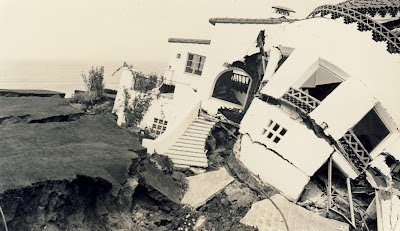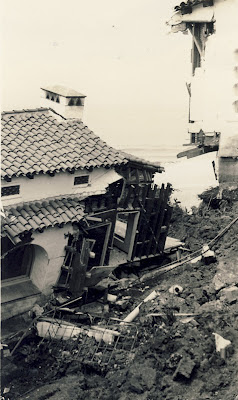 |
|
Untitled (Aftermath of Orange County Earthquake, 1933)
Unknown photographer; Orange County, California
Photograph; 2 7/8 x 4 1/2 in.
77.2.7e
Gift of Mrs. Donna Grauer
|
As So Cal natives we all experience unremarkable earthquakes on a regular basis.
They are a normal part of our lives, and as a result they have become more of an exciting curiosity rather than a dangerous threat to us. However, just within the past century there have been several earthquakes that caused large amounts of damage and took many lives. Eighty years ago, one of the most memorable earthquakes in Southern California ripped through parts of the Los Angeles and Orange Counties. This March 10, 2013 marks the earthquake's anniversary and an opportunity to commemorate a piece of local history as well as the lives lost in the tragic event.
 |
|
Untitled (Aftermath of Orange County Earthquake, 1933)
Unknown photographer; Orange County, California
Photograph; 2 3/4 x 4 1/2 in.
77.2.7b
Gift of Mrs. Donna Grauer
|
These photographs depict some of the damage that the 1933 Long Beach Earthquake caused to a private home in Santa Ana. Originating in the Newport-Inglewood Fault, the quake tore through Southern California with a magnitude of 6.4.
Throughout the region 127 people were killed, more than one thousand were injured, and about $30,000,000 to $50,000,000 worth of damages was caused. Long Beach suffered the worst by far, with about 70 fatalities and $20,000,000 worth of damages done to city buildings. Here in Santa Ana, the destruction was considerably less severe, but it was still devastating. Three people were killed by falling debris; a man and his wife were crushed under toppling bricks outside of the Rossmore Hotel and another man was hit by debris outside of the Richeliue Hotel. The city also suffered $150,000 worth of damages done to 50 of its major buildings.
The 1933 Long Beach Earthquake served as a “wake up call” to the government and was directly responsible for the creation of the first statewide policies mandated in California to regulate the earthquake safety of buildings. The Fields Act improved public school building safety and the Riley Act introduced legislation that required buildings to be able to withstand horizontal forces. More legislation has been made and policies have continued to evolve and, 80 years later, California buildings are still being retrofitted to withstand earthquake disasters. Earthquakes have played a major role in the rich history of our state and the constant threat of seismic disaster will continue to shape our laws and our lives.
All text and images under copyright. For permission to use or citation information please contact the Collection Department. Information subject to change upon further research.



Comments